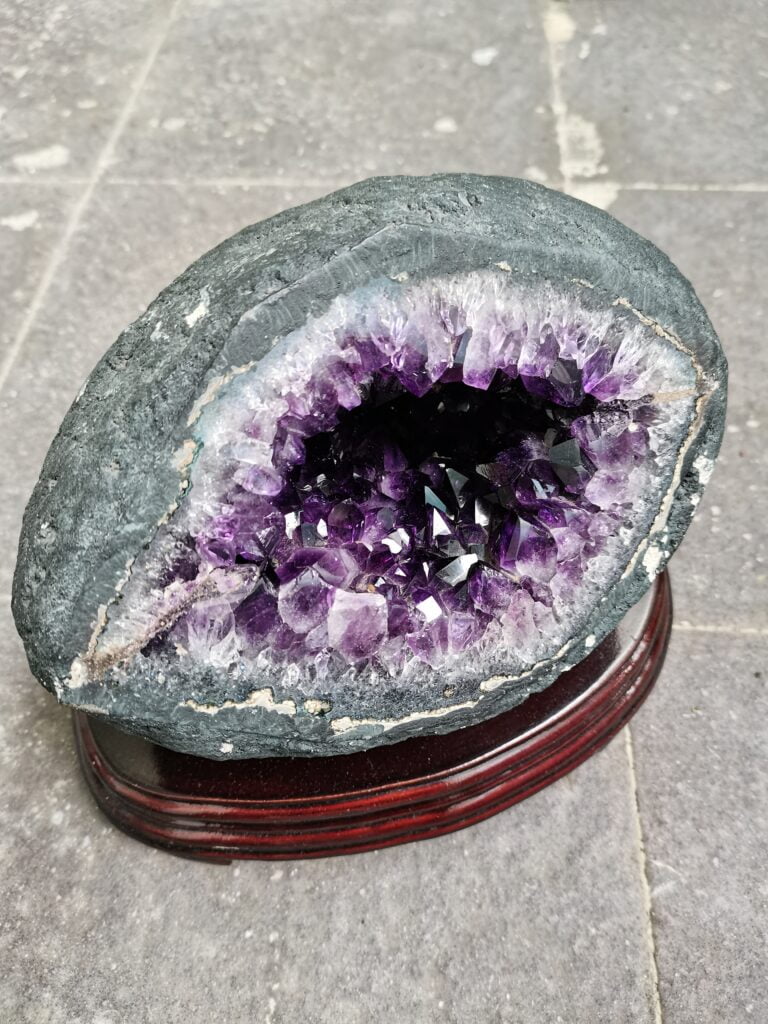Geode
A rather uninteresting rock on the outside hosting the beauty of nature inside, that is what a geode is all about. Geodes are roughly spherical rocks, typically containing a hollow cavity lined with minerals. Possible minerals range from quartz or calcite to fluorite. Geodes that are completely filled with compact microcrystalline minerals like agate and chalcedony would be called a nodule as they are solid throughout.
A common question we get asked is how do geodes form?
Geodes can be found in two types of rocks: igneous, and sedimentary rock, though it is more commonly found in the former than the latter.
Igneous rocks or volcanic rocks have produced some of the world’s finest geodes. Formed directly from magma below the surface of the crust, more specifically known as intrusive igneous rock, when gas failed to escape thus creating a cavity once the magma cools. Imagine making a pancake batter with bubbles, once it is cooked and sliced open you will see cavities left behind by the bubbles. Geodes that form from sedimentary rocks, on the other hand, can be caused by either dissolving of the core or cavity left behind by organic matter.
Once the outer part of the geode has been solidified, the second stage of formation takes place – the growth of minerals. As the porous geodes sit and wait, waves of hydrothermal fluids or groundwater flow through the host geode, bringing chemicals with them. When the chemicals slowly get deposited within, the first layer of mineral hardens on the wall. Agate or chalcedony usually make up the first layer in most geodes. With time, different temperatures and chemicals decide what crystallized mineral occupies the cavity.
The whole process takes millions of years to form, just like any other minerals and gemstones. The result is a rock with a tough exterior and crystalline interior, exposed to the surface by natural weathering for easy discovery and extraction. With a tough exterior, breaking geodes may not always be simple. The cheapest method to break it is by using the geode as a hammer and smashing it on a solid rock surface (definitely not your home tiles), although using an iron hammer with a chisel would be more practical. Some larger and tougher geodes need to be broken with a geode cracker.
Just like a Kinder Surprise, you will never know what you might find inside of a geode and that is one of the reasons why geodes are popular. The suspense, eagerness, and expectation during and after breaking process are all part of the geode-breaking enjoyment. However do not be surprised when it does not have crystals inside, nature does not always produce perfect minerals and gemstones.





Thank you for sharing this. I noticed there seems to be a large presence of amethyst geode in the market in recent years. I was wondering if it is possible to have artificial geodes / man made?
Hi Edmund, amethyst geodes are normally reinforced by cement… you can view it here https://www.mineral-forum.com/message-board/viewtopic.php?t=3853
I guess the demand of amethyst geode has risen over the years and therefore there is more supply now to meet the demand.
Kunming